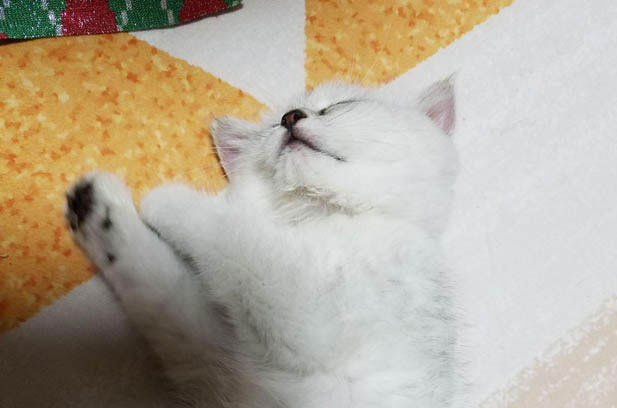In the field of cat breeding, there are some situations that seem hidden but are gradually becoming known to the public, especially those related to British Shorthair silver – shaded cats and their related breeds. Understanding this information can help cat lovers avoid misunderstandings and make more informed decisions when choosing and buying cats.
Let’s first talk about the phenomena that are not completely secret in the breeding circle. For example, silver – shaded and silver – tipped cats without nose lines and with pink paw pads are actually the offspring of British Shorthair pure white cats and silver – shaded or silver – tipped cats. British Shorthair pure white cats are rarely bred, and their market price is much cheaper than that of silver – shaded and silver – tipped cats. However, some unscrupulous merchants may sell these cross – bred cats at the price of pure – bred silver – shaded or silver – tipped cats, causing consumers to spend money unjustly. At the same time, it should be noted that blue – eyed pure white cats have a certain probability of being deaf. Recently, a friend on the Internet consulted me about wanting to adopt a pure white cat, which made me pay attention to this situation again. For those with such needs, it is very necessary to be aware of this risk in advance.

As someone who breeds silver – shaded cats at home, I know well the key points for judging their appearance. The appearance of silver – shaded cats should first be considered according to the standards of British Shorthair. They have round heads, thick bodies and limbs, wide ear distances, and small and round ears. In terms of coat color and eye characteristics, silver – shaded cats have unique requirements. Their eye pigmentation is mainly green, including grass green and other shades, and they should have clear nose lines and eye lines. However, among the offspring of silver – tipped and silver – shaded cats, there are also individuals without nose lines. Regarding paw pads, the common color is black, but there are also pink ones. In my personal opinion, it is similar to the 12 – color in golden – shaded cats, that is, the whiter the fur, the more popular it is.
In the breeding process, there are some points that need special attention. Be sure to avoid choosing the offspring of silver – shaded cats and Persian cats. Some breeders, in order to pursue whiter fur for cats, will use Persian male cats to mate with silver – shaded female cats, which has become a common practice in the industry. But the cross – bred offspring have disputes in terms of blood purity, and buyers are often easily misled. In addition, don’t believe the so – called “atavistic fluffy hair” statement. This is likely just a gimmick fabricated by some merchants to raise the price.
For consumers, whether a kitten has ringworm or ear mites is an important consideration. A kitten should be free of ringworm and ear mites as a basic hard – and – fast rule. If you have mature treatment measures for ringworm and ear mites, then you can choose a kitten with such problems when buying, but be sure to ask the seller for a price discount. After all, treating these diseases requires time and financial costs.
In terms of market prices, currently, the prices of silver – shaded and silver – tipped cats are on the rise. In our local area, pet stores purchase two – month – old silver – shaded female kittens without vaccines starting at 1500 yuan. The price of silver – tipped cats has also increased significantly. Now it can reach more than 4000 yuan. Many breeders who have adult female silver – shaded cats at home have chosen to breed them with silver – tipped cats, hoping to obtain higher economic benefits.
In conclusion, both breeders and consumers should have a clear understanding of these situations in the cat breeding circle. Breeders should uphold the principle of integrity and abide by breeding norms; consumers should enhance their discrimination ability and choose carefully to avoid losses due to information asymmetry, so that every cat can grow up healthily in a suitable environment.
Leave a Reply